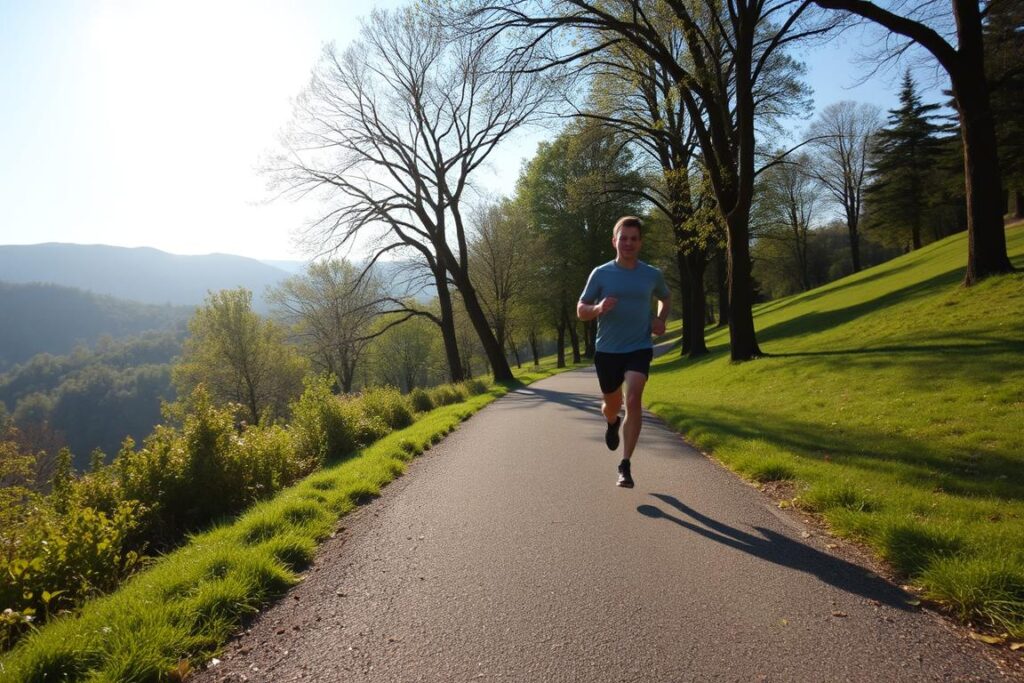Have you ever wondered how the aerobic exercise in fast affects your health? This practice is gaining popularity for those who want to lose weight and improve their health. It helps burn fat, increase insulin sensitivity and improve metabolism.
Studies show that the aerobic exercise in fast can help with weight loss. But it is important to do so in a safe and controlled manner. In addition, it is essential to drink water and eat important nutrients after exercising to recover and improve physical performance.
Practice the aerobic exercise in fast improves the health heart health and insulin sensitivity. It also helps control blood sugar. To lose weight, it is important to do so safely, with a low-calorie diet and training on alternate days.
It is crucial to remember that fasted aerobic exercise is not for everyone. Pregnant women, people with hypoglycemia or hypertension should exercise caution. Before starting, it is important to assess your overall health and fitness level. physical conditioning.
What is Fasting Aerobic Exercise?
Fasted aerobic exercise is exercising without eating first. It is usually done in the morning. This allows the body to use its energy reserves.
Studies show that people who exercise on an empty stomach burn more fat. This may also help prevent type 2 diabetes.
Definition and basic concepts
Physiological fasting lasts about 3 hours. It is safe for physical activity. Intermittent fasting, on the other hand, involves longer intervals between meals. It can be risky for intense exercise.
How it works in the body
When you exercise on an empty stomach, your body uses glucose first. Then, it starts burning fat. This can decrease your body’s efficiency over time.
Differences from conventional exercise
THE fasting training should be low intensity. It should not last more than 40 to 45 minutes. Walking and light cycling are good options.

To lose weight, do aerobic exercise on an empty stomach on alternate days. It is important to have a low-calorie diet. It is also essential to have a good physical conditioning.
Benefits of Fasting Aerobic Exercise for the Body
Fasted aerobic exercise is becoming popular. It helps with health and weight loss. When you exercise on an empty stomach, your body uses fat for energy. This can help you lose weight faster.
This type of exercise also improves insulin sensitivity. This is good for your metabolism. Fasting makes your body use insulin better, helping to control your blood sugar.
Another benefit is the increased metabolism. Using fat for energy causes the body to burn more calories. This helps you lose weight faster.

To get the most out of this exercise, follow these tips. Start with light, short workouts. Then, increase the volume of your workout.
- Start with low intensity and short duration training
- Gradually increase training volume
- Drink water before and during exercise
- Avoid supplements that become a source of energy
It is important to exercise in moderation. It is also essential to have medical supervision, especially if you have health problems.
| Benefit | Description |
|---|---|
| Fat loss | Increased burning of stored fat |
| Improved insulin sensitivity | Reduced insulin resistance and improved metabolic health |
| Increased metabolism | Accelerated metabolism and more effective calorie burning |
Scientific Aspects of Fasting Training
Understand the scientific aspects of fasting training is essential. It helps burn fat and improves insulin sensitivity. This can help with weight loss and maintaining a healthy weight.
A study of 33 sedentary women showed benefits. They were divided into three groups: fasting, food before training and high intensity training. The fasting group lost more fat.
You scientific aspects of fasting training include fat burning and improved insulin levels. It also increases metabolism. This helps those who are just starting to train.
The main advantages of fasting training are:
- Increased fat burning
- Improved insulin sensitivity
- Increased metabolism
- Reduced appetite
It is crucial to consult a doctor before starting. Hydration is essential before, during and after training.
Best Times to Practice
Choose the best times to exercise on an empty stomach is crucial. The morning period is ideal, according to studies. This is because it helps burn fat and increases energy.
Fasting for 12 to 14 hours is recommended. This allows the body to burn fat efficiently. Doing aerobic exercise on an empty stomach 3 to 4 times per week is the ideal frequency. Each session should last at least 30 minutes.
Ideal times can vary from person to person. This depends on the chronotype, the level of physical conditioning and training objectives. But generally, the best is the morning period.
Studies show that exercising on an empty stomach in the morning increases fat burning. It also improves insulin sensitivity. Regular exercise can help reduce the risk of heart disease and improve cardiovascular health. That's why it's essential to find the right best times to train and maintain a regular routine.
Types of Aerobic Exercises Ideal for Fasting
You types of aerobic exercises The ideal exercises for fasting are low intensity. They do not require much physical effort. Walking, light jogging and cycling are great for fasting. This is because the body uses fat for energy.
Some of the types of aerobic exercises that can be performed on an empty stomach include:
- Walking: A low-intensity activity that can be performed by people of all fitness levels.
- Light running: a moderate intensity activity that can be performed by people who already have developed physical fitness.
- Cycling: A low-intensity activity that can be performed by people of all fitness levels.
It is crucial to carry out the fast in a safe and healthy way. The maximum recommended duration is 40 to 45 minutes. Staying hydrated before, during and after exercise is essential.
In short, the types of aerobic exercises The ideal fasting regimens are low-intensity. They allow the body to use fat for energy. With caution, fasting can improve your health and fitness.
| Exercise Type | Intensity | Duration |
|---|---|---|
| To walk | Low | 30-45 minutes |
| Run light | Moderate | 30-45 minutes |
| Cycling | Low | 30-45 minutes |
Precautions and Contraindications
Fasted aerobic exercise can be beneficial for many people. But it is essential to think about the precautions and contraindications before you begin. It is important to know your general health and fitness level before you begin AEJ.
Some Groups of risk should be careful. This includes those with very low blood pressure or hypoglycemia. They may feel nauseous, dizzy, and unwell. It is also not recommended for pregnant women, children, and those who suspect they have an eating disorder.
Groups of risk
- People with very low blood pressure or hypoglycemia
- Pregnant women
- Children
- Individuals with suspected eating disorders
It is crucial to train on an empty stomach with precautions and professional guidance. It is also important to have an energy deficit throughout the day. This helps fasted training to be more effective.
In short, it is vital to think about the precautions and contraindications before starting fasted aerobic exercise. This is especially true for Groups of risk specific. With the right guidance and the precautions necessary, it is possible to take advantage of the benefits of AEJ safely and effectively.
How to Start Practicing Safely
To begin fasted aerobic exercise (FEA) with security, it is crucial to understand the gradual adaptation. Start with low intensity and gradually increase duration and intensity.
THE security is essential when practicing AEJ. Monitor your heart rate and blood pressure to avoid risks. It is also important to know your limits and not exceed them.
To begin with security, follow these tips:
- Start with low intensity and duration of 20 to 30 minutes
- Gradually increase intensity and duration over time
- Monitor your vital signs and be aware of your limits
- Practice in a safe environment and with supervision if necessary.
Furthermore, the gradual adaptation is essential to avoid injuries and ensure security. With regular practice, you can increase the intensity and duration of AEJ. This way, you will achieve better results while maintaining the security as a priority.
With these tips and the gradual adaptation, you'll be ready to start AEJ safely, helping you achieve your fitness goals.
| Exercise Type | Intensity | Duration |
|---|---|---|
| Walk | Low | 20-30 minutes |
| Race | Moderate | 30-45 minutes |
| Cycling | High | 45-60 minutes |
Pre and Post-Workout Nutrition
THE food Eating before and after your workout is essential for the success of fasted aerobic exercise. It is crucial to know what to eat before and after so that your body can recover well and make the most of the benefits of AEJ.
One pre-workout suitable can increase your energy and focus before exercise. Ingredients like L-carnitine and caffeine help burn fat. After your workout, post-workout It is vital for muscle recovery and replenishing energy.
Some tips for food pre and post-workout include:
- Consume a pre-workout 30 minutes before exercise to increase energy and focus.
- Ingest a post-workout rich in carbohydrates and proteins to help with muscle recovery and energy replenishment.
- Avoid excessive carbohydrate consumption before training to prevent muscle glycogen storage.
It is important to remember that the food pre and post-workout must be personalized. It must meet individual needs and training goals. Maintaining a food balanced and healthy diet is essential for overall health and well-being.
| Food | Pre-Workout | Post-Workout |
|---|---|---|
| Carbohydrates | Avoid excess | Ingest for recovery |
| Proteins | Ingest for energy | Ingest for muscle recovery |
| Fats | Ingest for energy | Ingest for recovery |
Conclusion
THE fasted aerobic exercise (FEA) It brings many benefits to health and weight loss. Research shows that it helps burn fat, improves insulin sensitivity and speeds up metabolism.
Before beginning AEJ, it is crucial to assess your overall health and fitness level. With care and knowledge, AEJ can be a great tool for improving your health and well-being.
Experts suggest doing AEJ with light exercise, such as walking or cycling, in the morning. Start with 10 minutes and work up to 45 minutes. This helps lower insulin and reduce body fat.
To get the best results from AEJ, it is important to follow a balanced diet. Avoid high-glycemic carbohydrates and eat more protein and healthy fats. This allows your body to use fat as energy, helping you lose weight effectively.


